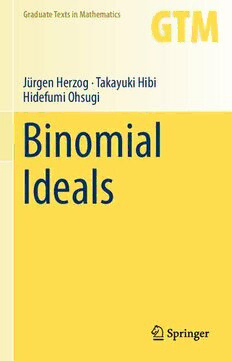
Binomial Ideals PDF
Preview Binomial Ideals
Graduate Texts in Mathematics Jürgen Herzog · Takayuki Hibi Hidefumi Ohsugi Binomial Ideals Graduate Texts in Mathematics 279 Graduate Texts in Mathematics SeriesEditors: SheldonAxler SanFranciscoStateUniversity,SanFrancisco,CA,USA KennethRibet UniversityofCalifornia,Berkeley,CA,USA AdvisoryBoard: AlejandroAdem,UniversityofBritishColumbia DavidEisenbud,UniversityofCalifornia,Berkeley&MSRI BrianC.Hall,UniversityofNotreDame J.F.Jardine,UniversityofWesternOntario JeffreyC.Lagarias,UniversityofMichigan KenOno,EmoryUniversity JeremyQuastel,UniversityofToronto FadilSantosa,UniversityofMinnesota BarrySimon,CaliforniaInstituteofTechnology RaviVakil,StanfordUniversity StevenH.Weintraub,LehighUniversity Graduate Texts in Mathematics bridge the gap between passive study and creative understanding, offering graduate-level introductions to advanced topics in mathematics. The volumes are carefully written as teaching aids and highlight characteristic features of the theory. Although these books are frequently used as textbooksingraduatecourses,theyarealsosuitableforindividualstudy. Moreinformationaboutthisseriesathttp://www.springer.com/series/136 Jürgen Herzog (cid:129) Takayuki Hibi (cid:129) Hidefumi Ohsugi Binomial Ideals 123 JürgenHerzog TakayukiHibi FakultätfürMathematik DepartmentofPure&AppliedMathematics UniversitätDuisburg-Essen GraduateSchoolofInformationScience Essen,Germany andTechnology OsakaUniversity HidefumiOhsugi Suita,Osaka,Japan DepartmentofMathematicalSciences SchoolofScienceandTechnology KwanseiGakuinUniversity Sanda,Hyogo,Japan ISSN0072-5285 ISSN2197-5612 (electronic) GraduateTextsinMathematics ISBN978-3-319-95347-2 ISBN978-3-319-95349-6 (eBook) https://doi.org/10.1007/978-3-319-95349-6 LibraryofCongressControlNumber:2018949912 MathematicsSubjectClassification(2010):13-01,05B50,05C25,13F20,13P10,13P25,52B20 ©SpringerInternationalPublishingAG,partofSpringerNature2018 Thisworkissubjecttocopyright.AllrightsarereservedbythePublisher,whetherthewholeorpartof thematerialisconcerned,specificallytherightsoftranslation,reprinting,reuseofillustrations,recitation, broadcasting,reproductiononmicrofilmsorinanyotherphysicalway,andtransmissionorinformation storageandretrieval,electronicadaptation,computersoftware,orbysimilarordissimilarmethodology nowknownorhereafterdeveloped. Theuseofgeneraldescriptivenames,registerednames,trademarks,servicemarks,etc.inthispublication doesnotimply,evenintheabsenceofaspecificstatement,thatsuchnamesareexemptfromtherelevant protectivelawsandregulationsandthereforefreeforgeneraluse. Thepublisher,theauthorsandtheeditorsaresafetoassumethattheadviceandinformationinthisbook arebelievedtobetrueandaccurateatthedateofpublication.Neitherthepublishernortheauthorsor theeditorsgiveawarranty,expressorimplied,withrespecttothematerialcontainedhereinorforany errorsoromissionsthatmayhavebeenmade.Thepublisherremainsneutralwithregardtojurisdictional claimsinpublishedmapsandinstitutionalaffiliations. ThisSpringerimprintispublishedbytheregisteredcompanySpringerNatureSwitzerlandAG Theregisteredcompanyaddressis:Gewerbestrasse11,6330Cham,Switzerland ToourwivesMaja,Kumiko,andNaoko,our childrenSusanne,Ulrike,Masaki,Ayako, Takuya,andTomoya,andourgrandchildren Paul,Jonathan,Vincent,Nelson,Sofia,and Jesse Preface Historically, commutative algebra, whose foundations were laid by Dedekind, Hilbert,Noether,andKrull,hasdevelopedinstepwithalgebraicgeometry,number theory, representation theory, combinatorics, and, recently, with statistics. The development of modern commutative algebra has been very much influenced by theworkofKaplansky[126],Zariski–Samuel[220],Nagata[151],andMatsumura [145]. The trend of combining commutative algebra with combinatorics originated in thepioneeringworkbyRichardStanley[194]in1975,wheresquarefreemonomial idealsplayedanimportantrole.Sincethen,thestudyofsquarefreemonomialideals from viewpoints of both commutative algebra and combinatorics has become a very active area of research. The standard references regarding this area include themonographsofStanley[199],Hibi[105],Bruns–Herzog[27],Miller–Sturmfels [146],Bruns–Gubeladze[25],andHerzog–Hibi[94]. Sincetheearly1990sbinomialidealsbecamegraduallyfashionable.Theynow appear in various areas of commutative algebra and combinatorics as well as of statistics.Acomprehensiveanalysisofthealgebraicpropertiesofbinomialideals, including their primary decompositions, was given by Eisenbud–Sturmfels [58]. Among the binomial ideals, toric ideals form a distinguished class which has first beenconsideredandstudiedbyConti–Traverso[41]inthealgebraicstudyofinteger programming by using the theory of Gröbner bases. Sturmfels, in his influential monograph [202], presented a first systematic treatment of toric ideals. Exciting applications of thetheory of toricideals and theirGröbner bases tostatisticswere firstexploredbyDiaconisandSturmfels[53]withcreatinganewareaofresearch, calledcomputationalalgebraicstatistics. Thepresenttextinvitesthereadertobecomeacquaintedwithcurrenttrendsinthe combinatorialandstatisticalaspectsofcommutativealgebrawiththemainemphasis onbinomialideals.Apartfromafewexceptions,wherewerefertothebooks[27, 135,145],onlybasicknowledgeofcommutativealgebraisrequiredtofollowmost ofthetext.PartIconsistsofaself-containedquickintroductiontothemoderntheory of Gröbner bases (Chapter 1) and of reviews on several concepts of commutative algebra (Chapter 2) which are frequently used in later chapters. Part II supplies vii viii Preface the reader with the ABC of binomial ideals (Chapter 3) and with that of convex polytopes (Chapter 4). Part III provides several aspects of the theory of binomial ideals.Topicsincludeedgeringsandedgepolytopes(Chapter5),join-meetideals offinitelattices(Chapter6),binomialedgeideals(Chapter7),idealsgeneratedby 2-minors(Chapter8),andbinomialidealsarisingfromstatistics(Chapter9).Each chapterofPartIIImaybereadindependently. Wearenowinthepositiontodiscussthecontentsofeachchapterofthepresent textindetail. Chapter1summarizesthefundamentalmaterialonGröbnerbases.Startingwith Dickson’s Lemma which is a classical result in combinatorics, the definition of Gröbnerbasesisintroducedandthedivisionalgorithmisdiscussed.Wethencome tothehighlightsofthefoundationofGröbnerbases,viz.,Buchberger’scriterionand Buchberger’s algorithm. Furthermore, the elimination theorem and its application arepresentedandthenotionofuniversalGröbnerbasesisconsidered. Chapter2introducesthenonspecialisttothealgebraicandhomologicalconcepts fromcommutativealgebra,whicharerelevantforthematerialpresentedinthistext. Topicsincludegradedringsandmodules,Hilbertfunctions,finitefreeresolutions, Betti numbers, linear resolutions, linear quotients, dimension and depth, Cohen– Macaulay rings, and Gorenstein rings. Gröbner basis techniques in the study of idealsandalgebrasarediscussedwithafocusonKoszulalgebras. Chapter 3 provides a short introduction to the main topics of the present text, namely, binomials and binomial ideals. Some of the elementary properties of binomialidealsarediscussed,includingtheimportantfactthatthereducedGröbner basis of a binomial ideal consists of binomials. Toric ideals are identified as those binomial ideals which are prime ideals. Special attention is paid to lattice ideals.FinallyGraverbases,Lawrenceideals,andsquarefreedivisorcomplexesare introducedandstudied. Chapter4isaquickintroductiontothefundamentaltheoryofconvexpolytopes. Integralconvexpolytopesaremainlystudied.Afterrecallingsomebasicdefinitions and facts on convex polytopes, the integer decomposition property and normality of convex polytopes are discussed. Then unimodular coverings together with unimodular triangulations of convex polytopes are introduced. Especially, the role ofGröbnerbasesinthemodernanalysisofconvexpolytopesisemphasized. Chapter5dealswithedgepolytopesandedgeringsoffinitegraphs.Theproblem whentheedgepolytopeofafinitegraphisnormalaswellastheproblemwhenthe toric ideal of an edge ring is generated by quadratic binomials is mainly studied. Theseproblems,whosesolutionsareprovidedinthelanguageoffinitegraphs,were thestartingpointontheresearchofedgepolytopesandedgerings.Furthermore,a characterizationfortheedgeringofabipartitegraphtobeKoszulissupplied. Chapter 6 offers the study on a special class of binomial ideals, the so- called join-meet ideals, which arise from finite lattices. In the algebraic study of join-meet ideals, Birkhoff’s fundamental structure theorem for finite distributive lattices together with a characterization of distributive lattices due to Dedekind is indispensable.Oneofthebasicfactsisthatthejoin-meetidealofafinitelatticeisa primeidealifandonlyifthelatticeisdistributive.Anexampleofamodularlattice Preface ix whose join-meet ideal is not radical is presented. In addition, join-meet ideals of non-distributivemodularlatticesandofplanardistributivelatticesarestudied. Chapter7isabigchapterwhosetopicisthestudyofbinomialedgeidealsarising fromfinitegraphs.Thisisoneofthemoststudiedclassesofbinomialideals.Their appeal results from the fact that the homological properties of these ideals reflect nicelythecombinatoricsoftheunderlyinggraphs.Abasicresultisthatthebinomial edge ideal of a finite graph possesses a squarefree initial ideal, which guarantees that the binomial edge ideal of a finite graph is radical. The study on primary decomposition,Cohen–Macaulayness,regularityaswellasKoszulnessofbinomial edge ideals is achieved. In addition, related classes of ideals such as permanental edgeidealsandLovas´z–Saks–Schrijveridealsarealsointroducedanddiscussed. Chapter 8 is devoted to the study of ideals generated by sets of 2-minors. Among them are ideals of adjacent minors, inner minors of collections of cells, and polyominoes. It is mainly discussed when the residue class rings by the binomial ideals of these types are integral domains, normal, Cohen–Macaulay, or Gorenstein. Furthermore, Gröbner bases as well as primary decompositions of these binomial ideals are studied. A pending question of polyomino ideals is to classifyallpolyominoidealswhichareprime.Inaddition,theconjecturethatevery polyominoidealisradicalisofinterest.Weshowthatapolyominoidealisprimeif thepolyominoissimpleandfindtoricpresentationsofsimplepolyominoes. Chapter 9 invites the reader, who has never studied statistics before, to explore theexciting newresearchareaofalgebraicstatisticsanditsrelationtotoricideals and their Gröbner bases. First, basic concepts on statistics are explained in detail. In our study on algebraic statistics, it is required to understand what the Markov chain Monte Carlo method is. Second, the relationship between Markov bases of contingency tables and the sets of binomial generators of toric ideals is studied withfascinatingapplicationsofcommutativealgebratostatistics.Furthermore,the role of normality of toric rings in statistics is examined, and toric rings and toric idealsofhierarchicalmodelsarediscussed.Finally,Segre–Veroneseconfigurations and nested configurations for testing independence in group-wise selections are introduced. Each section is concluded with a list of problems, which are intended to com- plement and provide better understanding of the topics treated there. References, backgroundandrelatedtopics,andresultsareexplainedinNoteslocatedattheend ofeachchapter. Wehavetriedasmuchaspossibletomakeourpresentationself-contained,and webelievethatcombinatorialistsaswellasstatisticianswhoarefamiliarwithonly basic facts on commutative algebra will be able to understand most of the present textwithouthavingtoconsultothertextbooksorresearchpapers. Essen,Germany JürgenHerzog Suita,Osaka,Japan TakayukiHibi Sanda,Hyogo,Japan HidefumiOhsugi March2017 Acknowledgments TheauthorsaregratefultoMinaBigdeli,MaryamMohammadiSaem,andAyesha Asloob Qureshi, who read parts of preliminary versions of the present textbook, for providing valuable comments and pointing out errors. Our special thanks go to Sara Saeedi Madani who carefully read large parts of Chapters 7 and 8, and to VivianaEneforreadingallchaptersofthebook.Theircommentsandsuggestions helped very much to improve the presentation in this book. Part of this textbook was written while the authors were staying at Mathematisches Forschungsinstitut OberwolfachinSeptember2015andinSeptember2016undertheRiP(Researchin Pairs)program.Theyverymuchappreciatethehospitalityandatmosphereprovided bytheinstitute.Finally,thesecondauthorissupportedbytheJSPS(JapanSociety for the Promotion of Science) Grants-in-Aid for Scientific Research (S) entitled “TheBirthofModernTrendsonCommutativeAlgebraandConvexPolytopeswith Statistical and Computational Strategies” (JP 26220701). To publish this textbook isoneofthemainactivitiesofthegrant. xi
